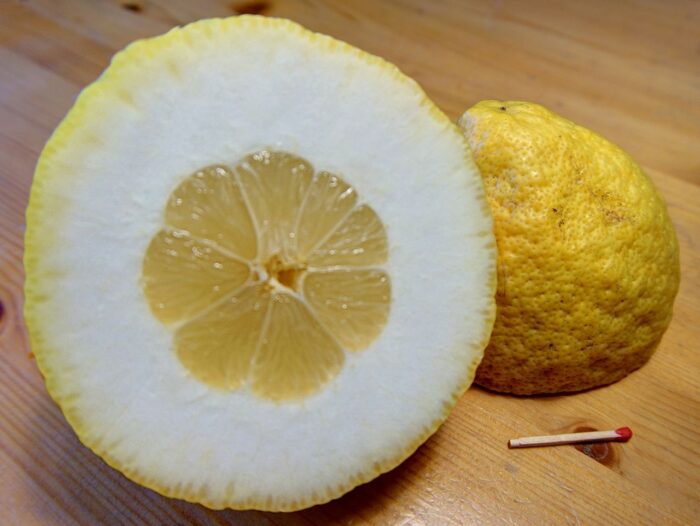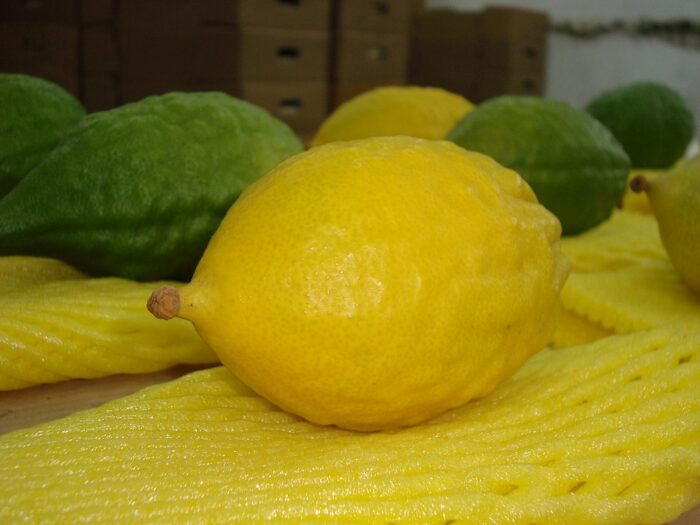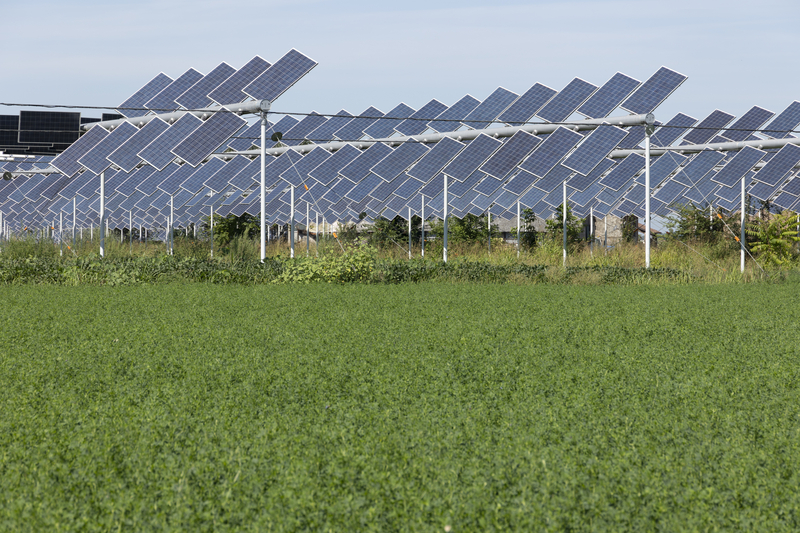May 6 to 21 is Science Odyssey, a celebration of all things science! OWLconnected is recognizing this two-week event with lots of science content, as well as with an amazing contest, presented by our friends at the Natural Sciences and Engineering Research Council of Canada (NSERC). Details are at the end of this post—be sure to enter!
If you speak French and we say 'citron', you will think 'lemon'. But in English, the citron is also its own type of fruit.
An amazing, ancient fruit!
From the outside, you would be forgiven for thinking that they looked like a large, kind of bumpy lemon. But if you cut inside, you would immediately notice the difference. That's the because the citron has an extremely thick rind (the white part that surrounds the pulp of the fruit). See?

The impressive rind found on the citron can either be candied in sugar to be eaten or turned into essential oils. (Wikimedia Commons)
Over the centuries, all kinds of other citrus fruits were bred from the citron to try to increase the amount of pulp and juice each fruit had. After all, that's the part of the fruit that people love to eat!
But the peel and rind is where all of the essential oils are stored. And these are things that have been prized for ages in perfumes. But as artificial scents have become more common and cheap, the demand for real citron oils has fallen.
In fact, an Italian variety of this fruit, called the Liscia Diamante ('smooth diamond' in Italian) was nearly driven to extinction as the popularity of the fruit fell. Farmers couldn't make enough money growing it.
But now some farmers, like Antonio Lancellotta of Scalea in southern Italy, are helping to save the fruit by growing new orchards. And they're doing it in an interesting way.
Under rows of solar panels!
What is agrivoltaics?

The Liscia Diamante, the variety of citron grown at Lancellotta's farm. (Wikimedia Commons)
Also known as agri-solar, agrivoltaics is the practice of combining solar power generation and farming.
Both of these practices happen in big open fields, and for good reason. They need a lot of sunlight to work! But they are usually done apart from one another. You either run a solar farm or a crop farm.
Agrivoltaics asks the question of, "Why not do both?"
View this post on Instagram
This was especially appealing to a farmer like Lancellotta because citron trees actually do the best when they have some shade. Full sun all the time is too much for the plants. So it works like this.
Primarily, Lancellotta makes money by selling the energy his solar farm produces. And he then uses the profits (money made) from this business to support growing citron. Even if the citron crops don't make as much money, overall he is fine.
In an interview with the BBC, he said that by having "another source of income from energy production, finally, farmers can regain bargaining power."
And citron? Well, a beloved fruit stays alive.
The future of farming?
An agrivoltaics farm in Japan. (Getty Embed)
Many experts say that agrivoltaics is the future of farming. For starters, the solar farms help farmers make a more stable living—solar power is always in demand and the Sun is (usually) shining!
The solar panels also provide natural shelter to plants that prefer shade. It's not just citron trees that benefit from the break in the sunshine and blistering summer temperatures.
It also means that there is less pressure on every crop to make money to keep a farm alive. And that helps to keep biodiversity alive.
One of the biggest issues in agriculture is a lack of diversity brought about by focusing on just one crop and excluding others. Farming is ultimately a business that needs to make money to survive. But this can mean that the crops that reliably make the most money get grown the most, while other crops get left behind.
For these reasons and more, many hope the agrivoltaics get used more and more to address how we farm in the future.
Contest alert
Don't forget to enter the Science Odyssey Contest! CLICK HERE TO ENTER.

 Agrivoltaics combines solar farms and traditional farming on the same land. (ID 228971326 © Roberto Dani | Dreamstime.com)
Agrivoltaics combines solar farms and traditional farming on the same land. (ID 228971326 © Roberto Dani | Dreamstime.com)









